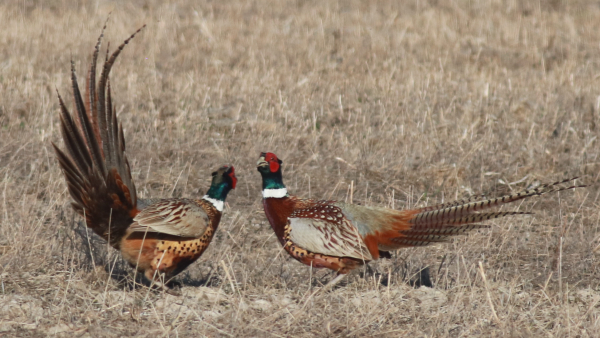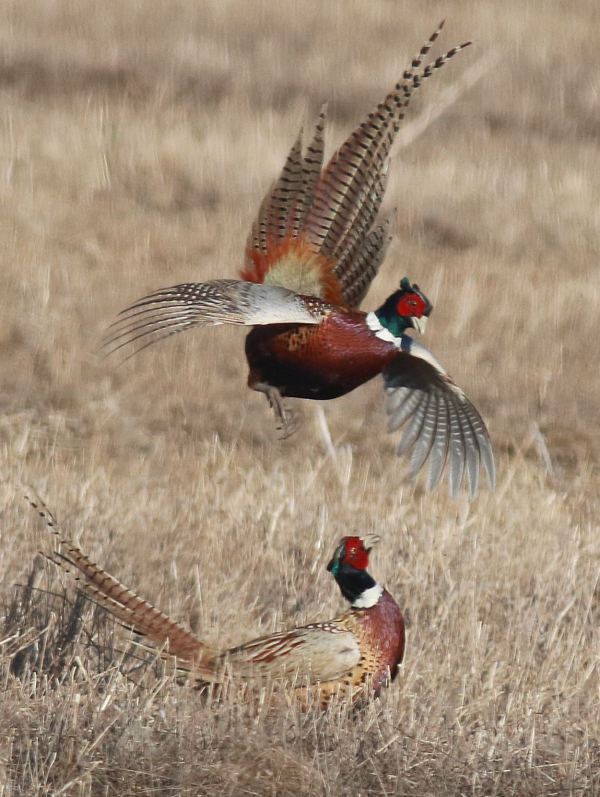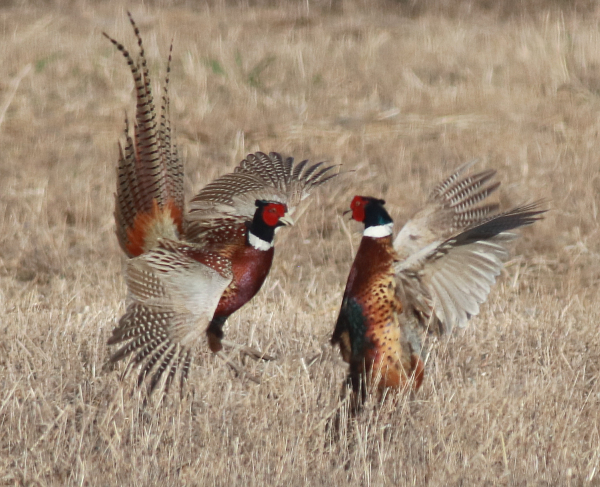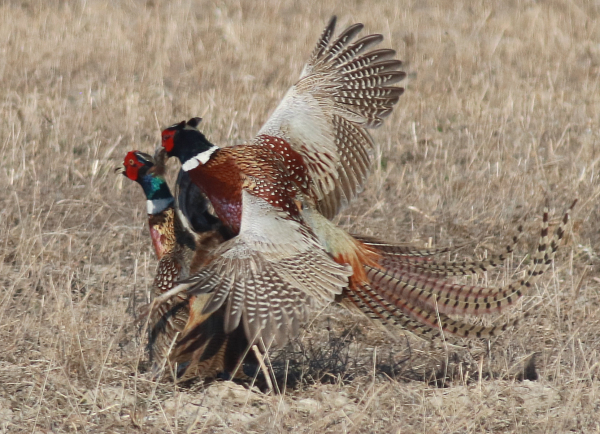
As I approached the pheasants’ position, they moved a short distance that must have been an unconscious compromise between keeping a “comfortable” distance from my vehicle and acting on their considerable antagonism toward one another.
|
Lately, I’ve been emphasizing the need to be aware of what’s happening around us, and being prepared for something out of the ordinary. Spring may be the best time for just these kinds of surprise events that transform before your eyes. During the past week there has been a big increase in the activities among Ring-necked Pheasants in my area of the Dakota borderlands – just north of South Dakota where this colorful species is recognized as the state bird.
Last Wednesday I turned the 2-hour drive to Bismarck into a 6-hour drive by emphasizing a search for photo opportunities at Long Lake National Wildlife Refuge, McKenzie Slough, and a couple marshes east of Bismarck. I eventually spent some time along the road that cuts through the center of McKenzie Slough, where there was a great variety of ducks, grebes, and nesting Canada Geese. With perfect lighting from the low sun of late afternoon-early evening, I became caught up with photographing some common species, displaying and singing blackbirds – Yellow-headed and Red-winged Blackbirds. I almost left a couple times, but continued to stay a little bit longer, kind of waiting for something more to happen among the variety of birds during this time of prime lighting. I was about to leave again when I heard a fight break out among a small growth of saplings just beyond the very south end of marsh – a cock fight!

By being positioned a little farther away than preferred, it was possible to keep both birds’ long tails and spread wings within the photo frame during their interactions.
|
Only by ear did I identify the action, but I was excited by the potential I imagined might transpire. I tried to slip quietly closer using my mobile blind (vehicle), but the pheasants reacted by walking east, into the open, and began facing off again, displaying by spreading their tails, and tipping their bodies toward one another. Then they erupted into a long series of fights, mostly jumping over one another, then clashing by kicking and pecking. They were just a little too far away, but I made the most of it and enjoyed documenting the action – what a thrill. I’ve seen such fights several times, but this was by far the longest battle I’ve witnessed, and it was my first opportunity to photograph the intensity of the territorial battle.
When I returned home I was excited to see the resulting photos on the big screen of my laptop computer. It was great fun to see the images, and I promptly selected and edited what I considered to be the best 10 photos, and I selected the 5 best to illustrate this article. I tried to present the photos in an order that provides something of a visual story, as well as a documentary illustration of a rarely observed and almost never photographed territorial fight between Ring-necked Pheasants.
Phight Settings
Two primary things made my photos as successful as they were: 1) Again, I was so lucky the sunlight was just right to provide fast shutter speeds with an adequate field of focus to include all the spread wings and tails of the two sparring males; and 2) I was equally lucky the birds were on the correct side of the road, with the pheasants in front of me and the low sun behind me.

Much of the “fight” involved various levels of bluffing, jumping, wing-flapping, and tail spreading with little real contact, but the action provided thrilling photo ops.
|
With full sunlight at a 45 degree angle from behind me, I knew I would get a corresponding fast shutter speed if I used a rather wide f8 aperture, and the resulting shutter speed was 1/2000 of a second – fast enough to stop most motion. I double-checked all the settings a couple times as I photographed, which I could readily see on the base of my camera’s viewfinder frame as I composed the photos.
I braced my camera lens against the vehicle’s window frame, held my breath, and let the autofocus do its thing. I tried to anticipate the action, which was surprisingly easy to do, and when the interactions became heated, I held the shutter release button down to allow the camera to take a continuous series of images at a rate of 3 to 5 photos per second. Although I would have liked to have been a little closer, being as far away as I was allowed me to keep both birds, including their long tail feathers, within the photo frames as I photographed.
Pheasant Phantasies

At times the action became more intense within close quarters, but contact still seemed rare. Good lighting allowed a fast shutter speed to stop the action with adequate depth of field to keep the birds in focus in most photographs.
|
I must admit that I had enough time as I photographed them, that I imagined how cool it would be if these Ring-necks were an even more exotic pheasant, say Golden Pheasants or Lady Amherst’s Pheasants – how’s that for fantasizing? (ha-ha) And that flash of thought provides an opportunity to highlight the family of pheasants, which is expansive, centered in southeast Asia, and made up of 22 primary species that also include Reeve’s Pheasants, Copper Pheasants, Swinhoe’s Pheasants, Silver Pheasants, and Elliot’s Pheasants; plus 4 eared pheasants, and 8 peacock pheasants. I have visited northeast China, and even saw a Ring-neck there, but wouldn’t it be remarkable to search for Goldens and Reeve’s and Mikado Pheasants – and frankly all the rest!
OK, back to reality, and back to the territorial Ring-necks, which were originally introduced to North America in the late 1800’s. I checked the time stamps on the series of photos I took of the sparring pheasants and found their bout continued about 7 minutes. During the time I photographed, I didn’t see any flying feathers but expect there must have been some light scratching and bruising. But overall, there was mostly a lot of bluff and fluff, jumping, wing beating, and kicking; although most of the kicking and wing-beating seemed to catch little more than fresh air, as evidenced in my stopped-action photos.
In the end, the apparent victor in the territorial battle merely chased after the bird that chose to turn tail, until they ended up running down the road in front of me. They dipped back into the grassy ditch, and separated by about 20 feet, both standing upright in the now yellowing light, which gave their colorful feathers a glowing hue. After a moment the winner flew north and the second-place finisher ran south, and that was that.

A final flash of fight seemed to prove the difference between the victor and the vanquished. What an exciting opportunity to take a series of action photographs that reflect the birds’ intensity during the rites of spring.
|
There’s always a bit of a let-down when a photo session ends; I take a deep breath or two, regain my composure, then think about what just happened – whoo-whoo! Invariably I take a moment to check a couple photos by “rewinding” to check for sharpness and color, and even though the small 3-inch monitor screen can be misleading, it’s somewhat reassuring to view some images and it can elevate my level of excitement again. Then I thank the birds and shout “What Luck!”
Spring migration and its lead into the mating and nesting season is heating up with the advance of May. I’ve already had my share of photo luck this spring, but I expect the best is yet to come. In the meantime, enjoy your time afield with your camera in hand!
Article and photos by Paul Konrad
Share your bird photographs and birding experiences at editorstbw2@gmail.com